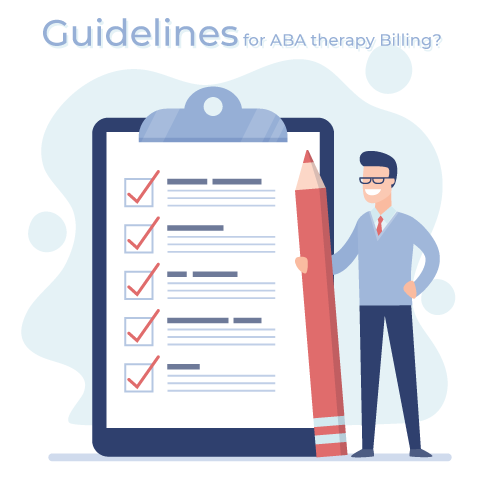General Guidelines for ABA Therapy Billing
The General Guidelines for ABA Therapy Billing refer to the general principles or best practices that providers of Applied Behavior Analysis (ABA) therapy services should follow when billing for their services. These guidelines are designed to ensure that services are accurately billed and reimbursed in a timely manner, while also complying with the requirements of insurance companies and regulatory agencies.
Some examples of the General Guidelines for ABA Therapy Billing include obtaining prior authorization before providing services, accurately documenting the services provided, using appropriate billing codes and modifiers, submitting claims in a timely manner, and keeping track of payments received.
Following these guidelines can help providers avoid errors and discrepancies in their billing, reduce delays in payment, and ensure that their clients are not responsible for unexpected costs. Overall, the General Guidelines for ABA Therapy Billing are designed to ensure that providers of ABA therapy services are able to provide high-quality, effective services while also maintaining compliance with industry regulations and standards.
Obtain prior authorization: Before providing ABA therapy services, it is important to check with the insurance company to see if prior authorization is required. This helps to avoid unexpected costs for the client and ensures that the services provided are covered under their insurance plan.
Accurately document services: Accurate documentation is crucial for successful ABA therapy billing. This includes documenting the type of service provided, the duration of the service, and any other relevant information. It is also important to ensure that documentation is clear and legible.
Use appropriate CPT codes: ABA therapy billing requires the use of specific CPT codes for the services provided. It is important to use the correct code for the specific service to avoid denial of payment. For example, using code 97151 for treatment instead of code 97152, which is the correct code for treatment, could result in a denial of payment.
Use modifiers: Modifiers are used to provide additional information about a service provided. For example, modifier 25 may be used when multiple services are provided in a single day, indicating that the services are distinct and separate from each other. It is important to use modifiers when appropriate to ensure accurate billing and reimbursement.
Billing frequency: The billing frequency for ABA therapy services can vary depending on the insurance company. It is important to check with the insurance company to determine the appropriate billing cycle. Some insurance companies may require monthly billing, while others may allow for quarterly or annual billing.
Timely submission: Timely submission of claims is important to avoid delays in payment. It is important to submit claims as soon as possible to ensure that payment is received in a timely manner.
Keep track of payments: Keeping track of payments received is important for accurate billing and reimbursement. It is important to follow up on any outstanding claims or denials to ensure that payment is received. This includes tracking any re-submissions, appeals, or disputes that may arise during the billing process.
Following these general guidelines for ABA therapy billing can help ensure that services are accurately billed and reimbursed in a timely manner. It is also important to stay up-to-date on any changes in insurance policies, billing codes, and regulations to ensure accurate and timely billing.
How does an ABA billing Services help in General Guidelines for ABA Therapy Billing?
An ABA billing software can be a useful tool for providers in following the general guidelines for ABA therapy billing. Here are some ways that an ABA billing software can help:
Automated insurance verification: Many ABA billing software programs offer an automated insurance verification feature that allows providers to quickly check whether prior authorization is required for ABA therapy services. This can save time and reduce the likelihood of unexpected costs for the client.
Accurate documentation: ABA billing software can help ensure that services provided are accurately documented, including the type of service, duration, and any other relevant information. This helps to ensure that documentation is clear and legible, and reduces the likelihood of errors that can result in denial of payment.
CPT codes and modifiers: ABA billing software can help ensure that the appropriate CPT codes and modifiers are used for each service provided. Some software programs have built-in code validation features that alert providers to any potential errors or discrepancies in their billing codes.
Billing frequency: ABA billing software can help ensure that claims are submitted on time by automatically generating billing statements and reminders for providers. This can help reduce delays in payment and ensure that providers are paid in a timely manner.
Payment tracking: ABA billing software can help providers keep track of payments received, as well as any outstanding claims or denials. Some software programs offer reporting features that allow providers to view their payment history and track any trends or patterns that may emerge over time.
Overall, ABA billing services can be a useful tool for providers in following the general guidelines for ABA therapy billing. It can help ensure accurate billing and reimbursement, reduce errors and discrepancies, and streamline the billing process for both providers and clients.



Comments
Post a Comment